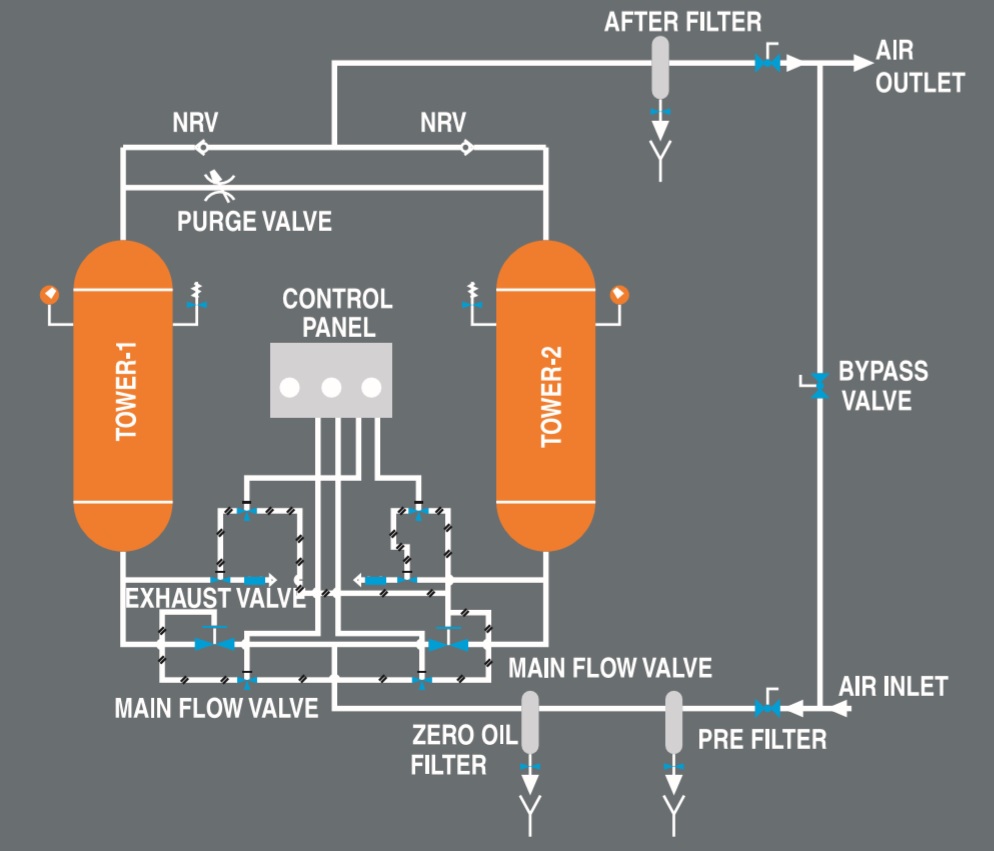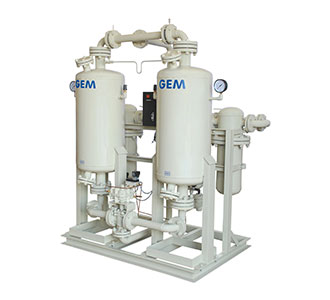General Features

Optional
Fill and drain ports:
- Separate fill and drain ports for ease of desiccant replacement.
- Heavy duty purge exhaust mufflers for quite operation.
- Non-lubricated inlet control valves.
- Purge flow valve for adjusting purge rate.
- Pressure relief valves on both towers.
Stainless steel support screens and air diffusers:
- Easy removable for cleaning.
- Filters out gross contaminants protect valves.
- Prevents channeling.
Structural Steel Frame with complete floor stand:
- Easy installation.
- Dryer is completely assembled, piped and wired before shipping.
- Optional factory mounting of pre and after filters.
- Shipped with full charge of desiccant. Choice between alumina or molecular sieve.
- Only hookup utilities need to operate.
- Lifting lugs for easy handling.
Filters
Pre Filter:
Every dryer should be equipped with pre-filter to protect the desiccant from free water contamination, dust, scales, etc., from compressed air supply. This assures top efficiency and longer desiccant life.
Zero Oil Filter:
Oil from the compressor's crank case will be passed on to the line with the compressed air. This will severely effect the life of the desiccant. To enhance, oil particles are removed in this filter upto 1 micron rating.
After filter:
This is provided after the dryer to remove the desiccant dust carried over to the equipment.
Technical Specification
| MODEL | Air Flow | Electrical Connection | Inlet / Outlet | Dimensions (mm) | Dessicant | Weight | |||||
| SCFM | Nm3 / hr | V | Ph | Hz | BSP | L | W | H | Qty/tower | Kg | |
| HLD-030 | 300 | 510 | 230 | 1 | 50 | 2" NB | 1400 | 1000 | 2400 | 110 | 350 |
| HLD-040 | 400 | 680 | 230 | 1 | 50 | 3" NB | 1400 | 1200 | 2480 | 140 | 400 |
| HLD-050 | 500 | 850 | 230 | 1 | 50 | 3" NB | 1600 | 1300 | 2230 | 180 | 500 |
| HLD-060 | 600 | 1020 | 230 | 1 | 50 | 3" NB | 1600 | 1300 | 2450 | 215 | 650 |
| HLD-075 | 750 | 1275 | 230 | 1 | 50 | 4" NB | 2000 | 1300 | 2200 | 260 | 800 |
| HLD-100 | 1000 | 1700 | 230 | 1 | 50 | 4" NB | 2000 | 1300 | 2500 | 360 | 950 |
| HLD-125 | 1250 | 2125 | 230 | 1 | 50 | 6" NB | 2000 | 1300 | 2750 | 450 | 1150 |
| HLD-150 | 1500 | 2550 | 230 | 1 | 50 | 6" NB | 2200 | 1400 | 2200 | 520 | 1400 |
| HLD-200 | 2000 | 3400 | 230 | 1 | 50 | 6" NB | 2200 | 1400 | 2860 | 720 | 1750 |






